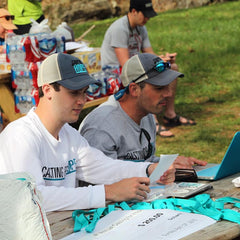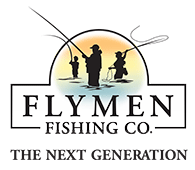3-minute fly: Tie quill body flies.

3-minute fly is a 6-part series by John Zimmerman of Casting For Hope and Upper Creek Angler.
Trees, rocks, big fish – they don’t care you spent half an hour on that perfectly tied fly.
I know because I’ve pleaded with them to give me back my precious flies before. Deaf ears!
I’ve been on a quest the last several years to identify simple flies that use simple, inexpensive materials, and take less than 3 minutes to tie. And I have a bunch of them.
Quill body flies.
This fly is effective on pressured fish who need a little more reason to eat — especially in slow moving water when pressured fish have a long time to look at flies before they commit to eating.
Just as The Sexy Walt’s and The Frenchie are simply tied patterns, so are these quill-bodied bugs.
One of the hallmarks of these simple flies is that there’s not a lot of junk on them to keep the fly from cutting through the water on its descent to the bottom. All that extra junk on flies can also spook fish hooked too many times for their own comfort.
If you’re over erasing or bleaching your own peacock quills, I can’t recommend highly enough the Polish Quills that my friend Wojtek is sending to the US. Upper Creek Angler is a proud dealer of all of their materials!
Fly tying materials
Hook: Here I’m using a #10 wide gap Orvis tactical hook, but you should use a wide variety of hooks and sizes to keep the pattern evolving in your box.
Bead: Nymph-Head® Evolution™ Swimmer & Burrower tungsten beadhead, olive – but try any variety of Nymph-Head® Evolution™, Heavy Metal™, or FlyColor™ beads in appropriate sizes; match colors to the quill color you’re using.
Thread: I’m using coffee colored Veevus in 8/0 here.
Body: Polish Quills – here I’m using Golden Olive (my favorite) but you should check out their full line. If your local fly shop doesn’t carry them, you can order them through me.
Collar: Here I’m using Whitlock’s SLF in Damsel Tan – but experiment!
Fly tying instructions
Step 1

Load and cement the bead with a thread base and a drop of Zap-A-Gap.
Step 2

Wrap rearward to the bend and tie in the tailing material – Coq de Leon is a very special fiber… but if you can’t find it, any hackle fiber will do.
Step 3

Spend some time working on your taper. If you don't, you’ll know it after you’ve started to wrap the quill.
Step 4

Tie in the quill and advance the thread to the top of the hook.
Step 5

Add a drop of varnish or super glue to add durability and then bring the quill forward with touching wraps. Tie off quill.
Step 6

Dub a collar and whip finish.
Go fishing!
Want more articles like this?
Join the Flymen Mailing List at the bottom of the page!
Be sure to read John's recent post, They're at your feet, dude! 6 reasons to make shorter casts when wade fishing.
About John Zimmerman:
 With Taylor Sharp (pictured left), John Zimmerman (right) is co-owner of Upper Creek Angler and co-founder and Chairman of the Board of directors of Casting for Hope. Upper Creek Angler is a guide and custom-built fly-rod service based in Morganton, NC. Casting for Hope is a regional nonprofit that serves women and families in Western North Carolina following a diagnosis of ovarian or other gynecological cancer through financial assistance and retreat programs. Casting for Hope’s flagship fundraiser is the only official Trout Legend Gold-Level fly-fishing competition on the east coast and one of just three in the United States. Watch the brief video below to learn more about Casting for Hope and the work John, Taylor, and their team are doing in WNC for women and families affected by ovarian and other gynecological cancers.
With Taylor Sharp (pictured left), John Zimmerman (right) is co-owner of Upper Creek Angler and co-founder and Chairman of the Board of directors of Casting for Hope. Upper Creek Angler is a guide and custom-built fly-rod service based in Morganton, NC. Casting for Hope is a regional nonprofit that serves women and families in Western North Carolina following a diagnosis of ovarian or other gynecological cancer through financial assistance and retreat programs. Casting for Hope’s flagship fundraiser is the only official Trout Legend Gold-Level fly-fishing competition on the east coast and one of just three in the United States. Watch the brief video below to learn more about Casting for Hope and the work John, Taylor, and their team are doing in WNC for women and families affected by ovarian and other gynecological cancers.


Comments on this post (5)
Hi,
What time of the year do you use this fly? What area do you fly cast with this fly?
Henry Hollis
— Henry Hollis
George, I’m almost exclusively a trout fisherman. I know—being one dimensional and myopic in my fly fishing pursuits isn’t necessarily a good thing. But every now and then I do find myself at the coast chasing red fish, which is a lot of fun, and every now and then, I do find myself teaching casting clinics on local ponds. My experience has been that bream/bluegill/sunfish (whatever you call that suite of fish that we all had so much fun with growing up) will eat trout flies. They definitely eat nymph patterns well as they also make their food living on underwater insects…they will murder worm patterns and egg patterns, too. And the girdle bug pattern that is forth coming…is a bream home wrecker and smallies will eat it, too! But all of the ones that I tied in the series were specifically simply-tied flies for chasing trout.
— John Zimmerman
Nice and useful fly!
— Martin Weaver
I’m new to fly fishing and I sometimes don’t know what types of fish go for them. Can the writers give any hints? Bass, panfish, trout, Ext. Great write ups, look forward to seeing them. George
— George Ellison
Interesting.
— Richard Davis